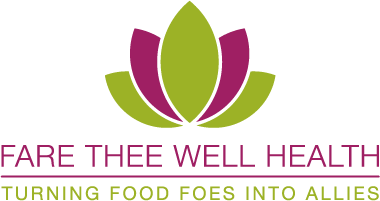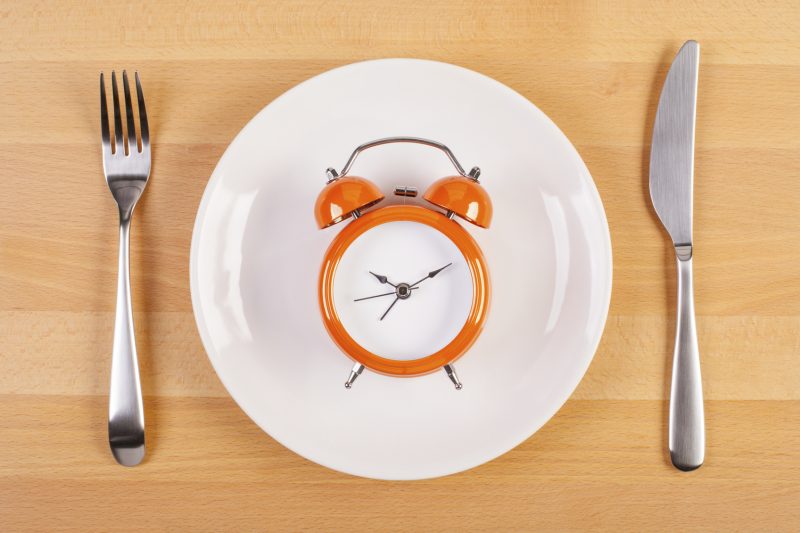Intermittent Fasting: My Surprising Allergy Aid
By Julie E. Williamson
About five years ago, my husband and I read an article on the merits of intermittent fasting (IF) – the practice of restricting food intake during certain periods for the sake of improved health and wellness (including weight control, insulin resistance, reduced inflammation and oxidative stress, and more.1,2,3,4) IF can be achieved a number of different ways, such as eating for a set period of time each day (e.g., an eight- or 10-hour window); a 24-hour fast once a week (eating at, say, 4 p.m. on a Tuesday and then not eating again until 4 p.m. the following Wednesday); or restricting calories to just 500 or 600 two days a week.
Although we were immediately intrigued by IF’s purported benefits, we dug into the research a bit more before giving it our personal green light. I read a book on the subject (“Intermittent Fasting: Everything You Need to Know about Intermittent Fasting” by Walter James Brown); Brian found an eye-opening BBC documentary called Eat, Fast & Live Longer; and we both scrolled and thumbed through scads of scientific literature (to our pleasant surprise, there’s significant evidence-based data – predominantly positive – on the subject). Satisfied with what we’d found, we decided to give it a try. We opted for the LeanGains IF method, which allowed us to choose our own eating/fasting window. Men are typically advised to pick an eight-hour eating window (leaving a 16-hour fasting window), so he picked 11 a.m. to 7 p.m. to allow him to eat a normal lunch and snack during work hours, and then finish his eating window with dinner in the 6 hour. To ignite the fire of a woman’s metabolism, the LeanGains approach recommends a 10-hour window. I chose 10 a.m. to 8 p.m., although I have to admit, I rarely eat past 7 p.m., so my actual window trends more in the nine-hour range.
If you’re reading this and believe IF sounds a bit like an exercise in starvation, rest assured, that hasn’t been our experience at all (no hangries in this household!). I’ve even tried the 24-hour fast and didn’t find myself in severe hunger mode (and, interestingly, my energy and mood stayed pretty high). I credit this to the way controlled IF is approached. Typically, when one thinks of a 24-hour fast, it’s assumed they will go all day without eating. While this may be true based on actual hours in a day (24 hours is 24 hours, after all), I’ve found that there is a significant difference between starting a fast at 7 a.m. and then not eating until the following morning at 7, as opposed to eating a satisfying meal in the mid to late afternoon and then waiting to eat at the same time the next day (this prevents you from going to bed with a grumbling belly – as long as you’re not filling up with empty calories). I’m also not a morning eater, which is why the occasional 24-hour fast worked well for me. Still, we found that the eight- and 10-hour eating window was simpler for us to follow, and it gave us some good results. It’s been so simple, in fact, that aside from a few “off” days here and there, we’ve adopted the IF approach as part of our daily lifestyle.
IF and allergies – an effective aid?
As one might expect, and as the research largely supports, Brian and I found weight management to be a notable benefit of IF. Although we do give in to our occasional sweet tooth or tempting greasy spoon grub, we tend to eat healthfully (plenty of lean protein and complex carbohydrates), which certainly helps, but there’s more to it. When we know our “window,” we can focus our attention on things other than food. When we first got started, we became keenly aware of how conditioned we were to eat (or graze) throughout the day, even when we weren’t necessarily hungry in a true physical sense. Rather than automatically waking up, pouring a cup of coffee and a downing a bowl of oatmeal or plate of eggs, we now start our day with a big glass of lemon water, which is surprisingly satisfying and came to prove what nutritionists have long reported: often, what we perceive as hunger is really just thirst in disguise (crazy as it sounds, it’s TRUE!). It’s worth noting that many IF methods allow you to drink black coffee or tea throughout the day, even during the fasting period. On Lean Gains, if you ingest fewer than 50 calories ahead of your window, you’re still considered fasting; however, if you exceed 50 calories, that means the eating window has officially begun (so if you loaded that coffee with cream or sugar, or popped a handful of berries in your mouth out of habit, be prepared to start the clock). The great thing about the IF lifestyle is that if you happen to be a big breakfast eater (or happen to awake one morning feeling famished), you can start your eating window earlier – say, from 7 a.m. to 3 p.m. if you’re a guy, and 7 a.m. to 5 p.m. if you’re a woman. Of course, you can start earlier or later to fit your schedule, as long as you don’t exceed your established eating window). Got it?
Our sleep improved, too, and along with that, our energy levels. I swear, even our skin perked up! I’m not sure if this is just wishful thinking, but I have at least convinced myself that my face looks more vibrant and my under eye circles are a whole lot less raccoon-ish.
The best benefit, though, at least for me, is that my allergy symptoms have noticeably lessened since adopting the IF lifestyle. IF has been shown to reduce inflammation in the body (a benefit largely supported by scientific literature), so that certainly plays a key role in my feeling better on the allergy front. While studies point to IF’s benefits with seasonal or environmental allergies, especially its role in improved pulmonary function (which is great news for asthma sufferers — again, due to IF’s anti-inflammatory effects), I’ve personally noticed a marked improvement in my food allergy-related symptoms, as well. It really makes sense when you think about it. When I’m limiting the hours of food intake, I’m giving my body a full 14 to 15 hours to calm itself and not have to constantly engage in a food-histamine tug of war. As a result, inflammation dies down and my symptoms (headaches, joint pain, gastrointestinal troubles, itchy/swollen mouth) subside.
Although IF hasn’t been a full-fledged silver bullet in regard to my allergy management, it’s definitely another weapon in my ever-expanding arsenal. For that reason, it’s one I’d recommend allergy sufferers consider trying for themselves. Word of caution: Before adopting IF (or any other big lifestyle change, for that matter), be sure to consult your doctor. IF isn’t right for everyone, including pregnant and nursing women, and those with diabetes or hypoglycemia.![]()
References
1. Johnson JB, Laub DR, John S. The Effect on Health of Alternate Day Calorie Restriction: Eating Less and More than Needed on Alternate Days Prolongs Life. Med Hypotheses. 2006;67(2):209-http://www.ncbi.nlm.nih.gov/pmc/articles/PMC1859864/
2. Alirezaei M, Kemball C, Flynn CT, Wood MR, Whitton L. Short-term Fasting Induces Profound Neuronal Autophagy. Autophagy. 2010 Aug 16; 6(6): 702–710. http://www.tandfonline.com/doi/full/10.4161/auto.6.6.12376.
3. Brown WJ. 2015. Everything You Need to Know About Intermittent Fasting.
4. Pilon B. 2015. Eat Stop Eat. 2014. http://www.eatstopeat.com







